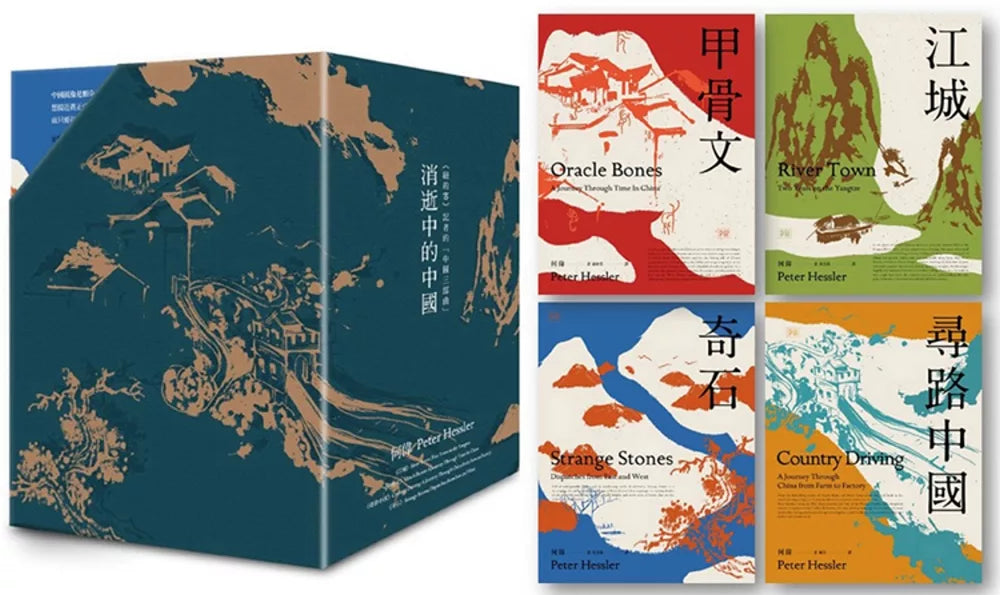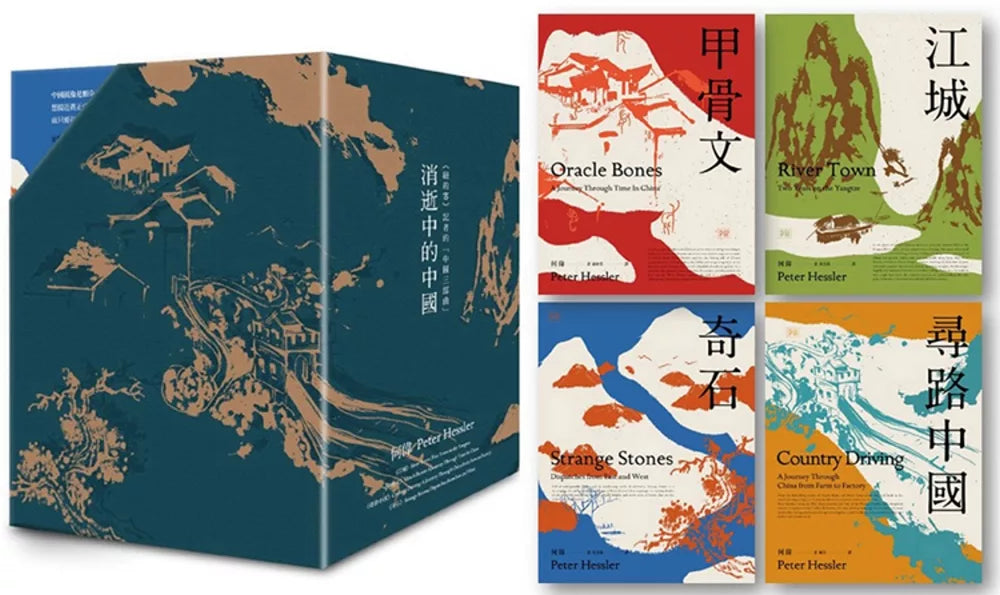1
/
of
1
Vanishing China: A Classic Collector's Edition of the "China Trilogy" by the Master of Nonfiction Writing and New Yorker Correspondent Peter Ho (All Four Volumes)
Vanishing China: A Classic Collector's Edition of the "China Trilogy" by the Master of Nonfiction Writing and New Yorker Correspondent Peter Ho (All Four Volumes)
Ho Wai Wu Meizhen, Lu Qiuying, and Lai Fang 译
Regular price
$35.99 USD
Regular price
Sale price
$35.99 USD
Unit price
/
per
Low stock
Couldn't load pickup availability
About Book
About Book
River Town: Two Years on the Yangtze, Oracle Bones: A Journey Through Time In China, Country Driving: A Journey Through China from Farm to Factory, Strange Stones: Dispatches from East and West
The book has won the Time Magazine Best Book Award and the National Book Award for Best Non-Fiction. It has also been selected as a Book of the Year by The Economist, The New York Times, The Washington Post, and Amazon.★
Internationally acclaimed and crowned as the finest example of contemporary non-fiction writing, the "China Trilogy" is a classic collection of all four volumes!
★
"China's existence seems to be for the purpose of making Ho Wei's writing possible."
Peter Hessler, a reporter for The New Yorker, has spent ten years exploring China, writing about the real China that is hidden from the media and invisible to you!
Ⅰ《River City》 ★ ★ ★ ★ ★ ★ ★ ★ ★ ★ ★ ★ ★
This voyage is like a dream, full of quiet rivers,
Cabins filled with passengers drifting off to sleep, and the lights of the city rising from the dark Yangtze River.
And Fuling is like a place to temporarily interrupt this dream.
The ancient Greek philosopher Heraclitus said, "One cannot step twice into the same river," for as rivers flow, the waters flow, and the present moment fades. But modern people can step twice into the same river city, as Ho Wei, who lived along the Yangtze River, spent two years writing about Fuling, Sichuan. This book is a memoir, a travelogue, and a keenly observed anthropology. In the quiet passage of time, within and beyond the rapidly changing urban and rural landscape, Ho Wei lived by the river, experiencing the daily details of his interactions with students and the people of Fuling, and unearthing a history of the mind and underlying stories that even the Chinese themselves have failed to grasp.
Mountains and rivers can be changed, but cities are hard to move. Whether the situation is declining or rising, we can always return to the river city of Fuling, because this is the birthplace of a series of documentary books written by Ho Wai and the starting point of Ho Wai's China trilogy.
──The birthplace of Ho Wai-fei's fictional writing and the initial starting point of his "China Trilogy"!
Ⅱ Oracle Bone Script ★ ★ ★ ★ ★ ★ ★ ★ ★ ★ ★ ★
How does a piece of oracle bone connect to the changing China today, thousands of years later?
The cracks on the oracle bones bear the scars of China's experience over thousands of years.
Can the oracle inscriptions, written and carved word by word, foresee China's future?
From Beijing to Henan, from Northeast China to Xinjiang, from Wenzhou to Shenzhen, He Wei's journey through China possesses not only a literal dimension but also a historical and metaphorical one, the two intertwined and interwoven like cracks in a tortoise shell. In his book, he focuses on ancient artifacts, such as bronze vessels from Yinxu and bronze heads from Sanxingdui. He interviews experts from China, the US, and Japan, exploring the discovery of ancient Chinese characters, the phoneticization of Chinese characters, and the debate over simplified and traditional Chinese characters. He also unearths the story of Chen Mengjia, a paleographer who was murdered during the Cultural Revolution, thereby closely connecting historical and cultural China with contemporary China.
In Oracle Bones, Ho Wei depicts a China that is more authentic and emotional than the real China itself, inviting readers to enter and experience it for themselves. He travels and visits diverse places, encounters diverse people, and encounters a series of ukiyo-e paintings of contemporary China, interwoven with joy, ambition, anger, impetuousness, chaos, and loss.
──Today's China seems to exist just for Ho Wei's writings!
Ⅲ《Finding My Way in China》 ★ ★ ★ ★ ★ ★ ★ ★ ★ ★ ★ ★ ★
No one has delved as deeply into China or seen it as carefully as he has.
With a warm and human gaze, Ho Wei records the joys and sorrows of life in every corner of China;
What he captured is a picture of how contemporary China is driven by an inexplicable and rapid force.
Following the ruins of the Great Wall, he journeyed to villages where the ancient walls remained. The bricks, having defended the area against the barbarians for centuries, remained intact, but the young people had long since left for the south along the newly paved roads, seeking opportunities, leaving the elderly, disabled, and young children alone in their brown, bare, and barren hometowns. Living among the rural valleys, he observed how the twin forces of traditional politics and the rise of commerce subtly transformed a small mountain town, shaping the lives of its simple inhabitants. Visiting a newly built factory, he witnessed the rise and fall of a bra parts factory and the lives of migrant workers, witnessing China's version of the Industrial Revolution and how the natural landscape was lost in this transformation.
Three long-term records, both realistic and humorous, both ironic and richly emotional, interweave time and text like longitude and latitude. With his penetrating portrayal, Ho Wei constructs the plight of ordinary people in an era of rapid economic growth and rapid social change in modern China.
──Ho Wei is like a modern-day Marco Polo, completely subverting your imagination of a transforming China!
IV. Strange Stones ★ ★ ★ ★ ★ ★ ★ ★ ★ ★ ★ ★
China is like a strangely shaped stone; everyone sees it differently.
The only way to get closer to the real China is to live in China for a long time;
And through Ho Wai's writing, you can read about the bizarre and ever-changing China.
With the opening of the economy and rapid urban growth, writing about China itself, and indeed about the country's significance to the world, has become a truly challenging undertaking. "Strange Stones," hailed by the editor-in-chief of Time magazine as "the best long-form reporting," is precisely because Ho Wei, over the past decade or so of China's rise, has repeatedly used humorous and vivid real-life stories to capture the unique face of a changing China.
For readers familiar with the "China Trilogy" that includes "River City," "Oracle Bones," and "Searching for China," "Strange Stones" can be considered a "side story"—a prequel to the trilogy, a reflection on the emotional journey behind its creation, and a glimpse into the subsequent developments of the people, events, and places depicted in the book. Reading this book is the best way to get to know Ho Wai and his approach to "non-fictional writing." Whether it's China or the world, through Ho Wai's pen, you'll find stories with unconventional themes and multidimensional perspectives, just like the strange stones.
──Following the "China Trilogy", a selection of in-depth reports from "The New Yorker" is rewritten!
Publication Date
Publication Date
2020-04-15
Publisher
Publisher
八旗文化
Imprint
Imprint
Pages
Pages
184
ISBN
ISBN
9789578654990
share

